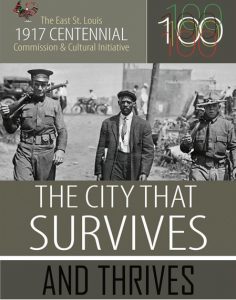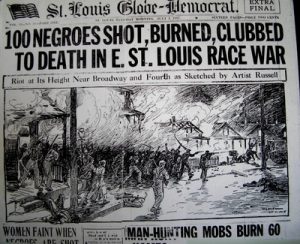Centennial anniversary remembers victims of East St. Louis Race Riot
By Bob Pieper For Chronicle Media — July 11, 2017New riverfront monuments dedicated to victims of the 1917 East St. Louis Race Riot are, so far, the most visible product of The East St. Louis Centennial Commission and Cultural Initiative (CCCI).
However, Centennial Commission Chair the Rev. Joseph Brown, S.J., is hoping the initiative — commemorating the 100th anniversary of the deadliest race riot in U.S. history — will ultimately serve to help ease tensions and promote constructive dialogue across the St. Louis region and the nation.
“Our goal is to promote remembrance, healing, and awareness of the 1917 Race Riots and its social, political, and cultural impact on our nation. We also want to help usher in a revitalization to the city of East St. Louis and build a brighter future for generations to come,” the commission declares on its website (www.estl1917ccci.org)
Also known as the East St. Louis massacres, the riots were an outbreak of labor- and race-related violence from May 28 through July 2, 1917, variously estimated to have caused between 40 and 200 deaths as well extensive property damage. White mobs, inflamed over labor inequities, beat, shot and lynched African Americans. They have been described as the worst case of labor-related violence in 20th-century American history and among the worst race riots in U.S. history.
Commemorative activities began with “A Day of Honor,” June 30, with an East St. Louis 1917 Centennial Commemoration Formal Program and Lowering of Flags at the St. Clair County Courthouse in Belleville.
“A Day of Remembrance,” July 1, offered presentations, tours of the riot-torn area and the unveiling of “sacred sites” markers at the scene of significant events in the rioting. Previews of two documentary films, “Against All of the Odds” and “Never Been a Time”; a reading of a new play, “Tinderbox,” and a youth symposium were offered at the East St. Louis Higher Education Campus.

The 1917 riots are often cited as a watershed event which effectively spawned the American civil rights movement, Charles Lumpkins, author of the book “American Pogrom: The East St. Louis Race Riot and Black Politics,” noted during his conference lecture.
The new monuments in the Malcolm Martin Park and on Eads Bridge were dedicated July 2 as part of “A Day of Reconciliation” event; encompassing a service at the Truelight Baptist Church, a commemorative processional along the Downtown East St. Louis Riverfront to the center of Eads Bridge, and a multi-faith blessing of the monuments.
The processional across Eads Bridge — highlighted by a release of sky lanterns from the bridge desk— recalled the estimated 7,000 black East St. Louisans who fled across the river during the riots to permanent exile in St. Louis, organizers say.
Additional cultural, entertainment and commemorative festivities were held on the riverfront landing and at the America’s Center convention complex in Downtown St. Louis that evening.
Established by the City of East St. Louis in 2014 and co-chaired by East St. Louis business man Edmund Brown, the CCCI is a coalition of area academics, civic leaders, artists, political figures, and business people.
Observances began this year on May 26-28 with a conference, “The City that Survives: Commemorating the Past and Preparing for the Future at the East St. Louis Higher Education Center,” with a variety of lectures, previews of the June 30-July 2 activities, and a fundraising reception for the monuments.
The 1917 riots are often cited as a watershed event which effectively spawned the American civil rights movement, Charles Lumpkins, author of the book “American Pogrom: The East St. Louis Race Riot and Black Politics,” noted during his conference lecture.

Mob stops a street car during the East St. Louis Riot, July 2, 1917 (Photo courtesy of University of Massachusetts)
However, they have been virtually forgotten in the St. Louis region today, observed speaker Samanthé Bachelier, citing her recently completed Southern Illinois University Edwardsville master’s thesis, “Hidden History: The Whitewashing of the 1917 East St. Louis Race Riot in the Collective Consciousness of the Greater St. Louis.”
CCCI leaders are hoping that will change. This past weekend also marked the official opening of permanent CCCCI offices in East St. Louis City Hall.
UPCOMING EVENTS/INFO
- The Making of an All-America City: East St. Louis at 150” panel discussion and book signing, July 19, at the Missouri History Museum’s Lee Auditorium in St. Louis, and
- An “East St. Louis Story” documentary film screening and book signing, also at the Missouri History Museum auditorium.
- The CCCI plans more events in August.
A brochure for self-guided tours of sites significant in the rioting can be downloaded on the CCCI website, which also offers archival film footage of the riots. Additional photographs and oral histories are to be posted in the near future.
Those wishing contribute artifacts, information, volunteer labor or funding to the initiative can contract the CCCI at info@estl1917ccci.org, (618) 555-1234, or East St. Louis 1917 CCCI, Inc., P.O. Box 6045, East St. Louis, IL 62202.
— Centennial anniversary remembers victims of East St. Louis Race Riot —-




